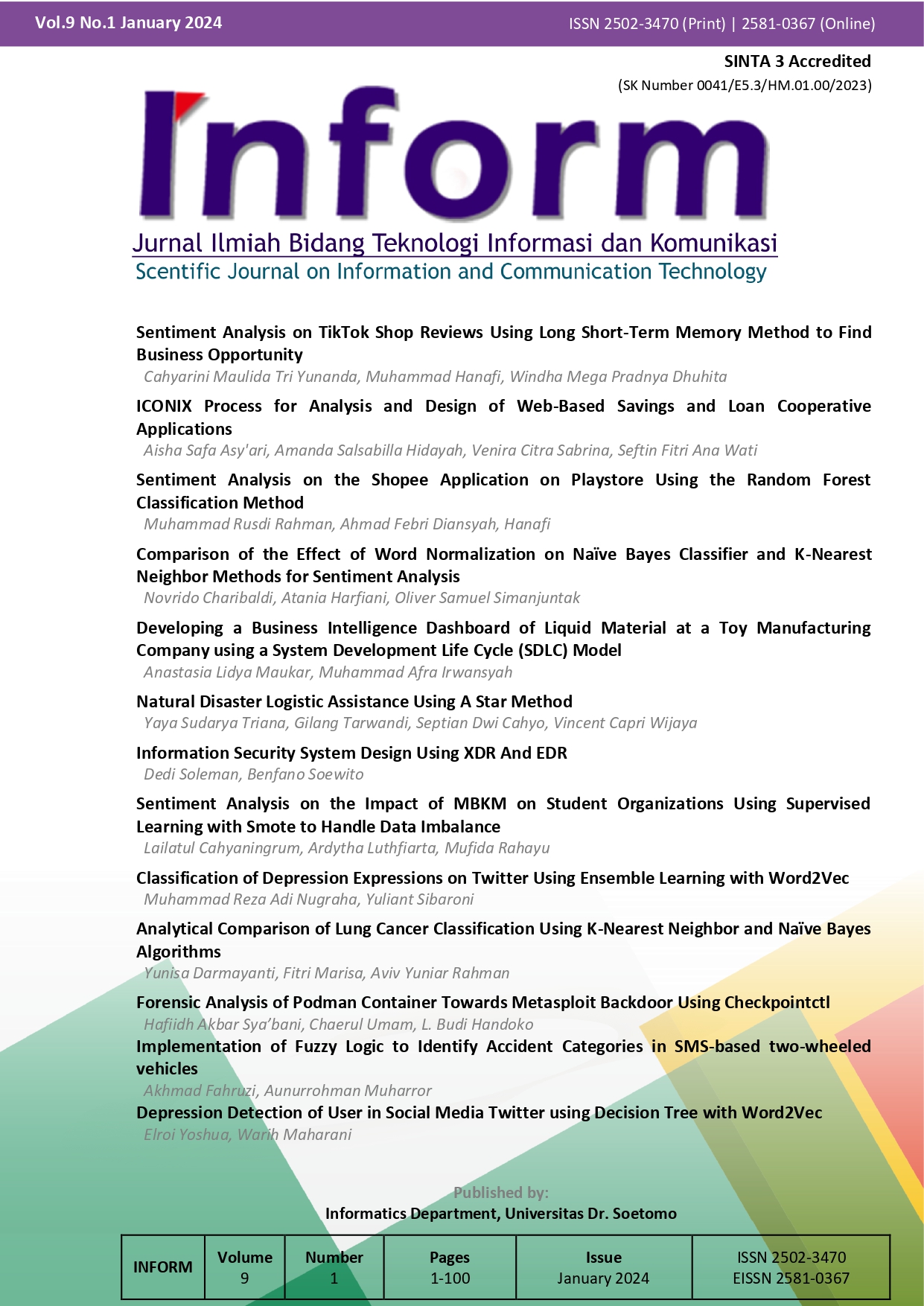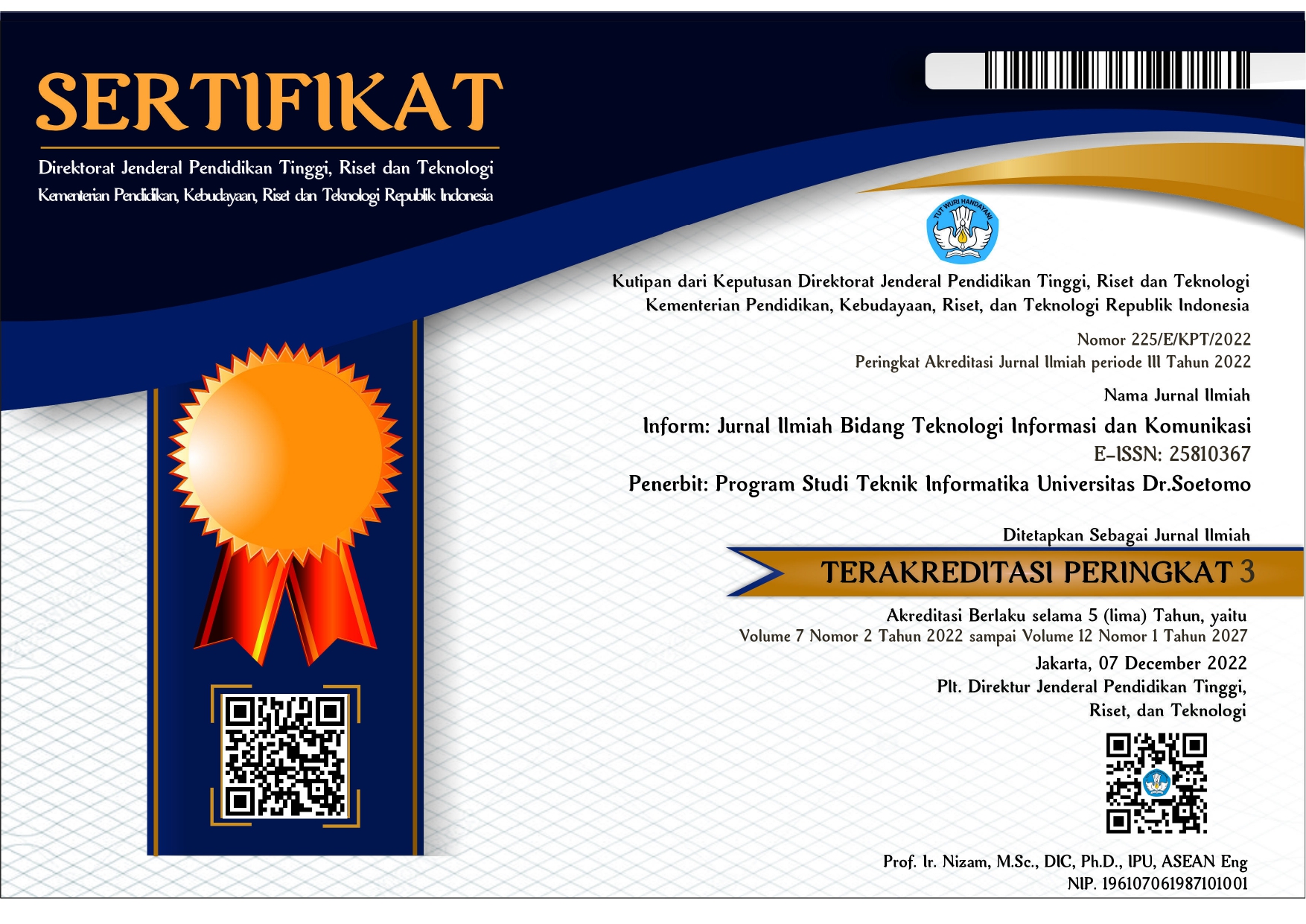Depression Detection of Users in Social-Media Twitter Using Decision Tree with Word2Vec
 Abstract views: 553
,
Abstract views: 553
,
 PDF downloads: 284
PDF downloads: 284
Abstract
Social media is a medium or place on the Internet that allows users to be themselves. Interact, cooperate, share, and communicate with other users virtually. Not only do users share happy feelings, but they also share their emotions and sentiments towards a particular issue. Which sometimes makes users look depressed when they deliver it. Depression itself is the most commonly encountered mental illness, which makes the sufferer feel sad, lonely, inferior, and disconnected from the people around them. And even worse, depression can make the sufferer have suicidal thoughts. Therefore, we need to know whether the user indicated being depressed or not to prevent unwanted things by using a depression measurement tool scale called DASS 42 for data labeling. To detect depression, we can use the sufferer's Twitter account to take data based on tweets from the user and change the entire dataset to a vector using both the architectures of Word 2, Vec Skip-Gram, and CBOW. In this research, we utilize a decision tree to detect depression. The best results were obtained from the Word2Vec Skip-Gram model with a data ratio of 90:10 using the Gini criterion parameter and a maximum depth value of 20, resulting in an accuracy of 93% and a f1-score of 94%.
References
I. Santoso, S. Wahyudi, A. Putra, and A. Purwana, “Komunikasi Dan Mitigasi Berita Bohong Di Media Sosial Oleh Pemerintah,” Gagasan Komun. Untuk Negeri, p. 184.
A. S. Cahyono, “Pengaruh media sosial terhadap perubahan sosial masyarakat di Indonesia,” Publiciana, vol. 9, no. 1, pp. 140–157, 2016.
A. Setiadi, “Pemanfaatan media sosial untuk efektifitas komunikasi,” Cakrawala J. Hum. Bina Sarana Inform., vol. 16, no. 2, 2016.
Social Media in Indonesia, "Stats & Platform Trends | OOSGA," 2023. [Online]. Available: https://oosga.com/social-media/idn/
P. Felita, C. Siahaja, V. Wijaya, G. Melisa, M. Chandra, and R. Dahesihsari, “Pemakaian media sosial dan self concept pada remaja,” Manasa, vol. 5, no. 1, pp. 30–41, 2016.
A. Rosmalina and T. Khaerunnisa, “Penggunaan Media Sosial dalam Kesehatan Mental Remaja,” Prophet. Prof. Empathy, Islam. Couns. J., vol. 4, no. 1, pp. 49–58, 2021.
A. Dirgayunita, “Depresi: Ciri, penyebab dan penangannya,” J. An-Nafs Kaji. Penelit. Psikol., vol. 1, no. 1, pp. 1–14, 2016.
World Health Organization, "Depresion WHO." [Online]. Available: https://www.who.int/health-topics/depression#tab=tab_
R. L. Atkinson, R. C. Atkinson, and E. R. Hilgard, “Pengantar Psikologi Edisi 8,” Erlangga, Jakarta, 1991.
W. Sulistyorini and M. Sabarisman, “Depresi: Suatu tinjauan psikologis,” Sosio Inf. Kaji. Permasalahan Sos. dan Usaha Kesejaht. Sos., vol. 3, no. 2, 2017.
M. R. Islam, M. A. Kabir, A. Ahmed, A. R. M. Kamal, H. Wang, and A. Ulhaq, "Depression detection from social network data using machine learning techniques," Heal. Inf. Sci. Syst., vol. 6, no. 1, pp. 1–12, 2018, doi: 10.1007/s13755-018-0046-0.
N. Hayatin, “Implementasi Multinomial Naïve Bayes Untuk Klasifikasi Data Tweets Mengandung Term Depresi,” in Prosiding SENTRA (Seminar Teknologi dan Rekayasa), 2021, pp. 344–349.
A. P. Tirtopangarsa and W. Maharani, "Sentiment Analysis of Depression Detection on Twitter Social Media Users Using the K-Nearest Neighbor Method," in Seminar Nasional Informatika (SEMNASIF), 2021, pp. 247–258.
M. R. Hidayatullah and W. Maharani, “Depression Detection on Twitter Social Media Using Decision Tree,” J. RESTI (Rekayasa Sist. dan Teknol. Informasi), vol. 6, no. 4, pp. 677–683, 2022.
N. Shayan, A.-R. Niazi, A. Waseq, and L. ÖZCEBE, "Depression, anxiety, and stress scales 42 (DASS-42) in Dari-language: validity and reliability study in adults, Herat, Afghanistan," Bezmialem Sci., vol. 9, no. 3, 2021.
L. Parkitny and J. McAuley, "The depression anxiety stress scale (DASS)," J. Physiother., vol. 56, no. 3, p. 204, 2010.
N. G. Bilgel and N. Bayram, "Turkish version of the depression anxiety stress scale (DASS-42): Psychometric properties," 2010.
S. Kusumadewi and H. Wahyuningsih, “Model Sistem Pendukung Keputusan Kelompok untuk Penilaian Gangguan Depresii, Kecemasan dan Stress Berdasarkan DASS-42,” J. Teknol. Inf. Dan Ilmu Komput., vol. 7, no. 2, pp. 219–228, 2020.
S. R. Marsidi, "Identification of Stress, Anxiety, and Depression Levels of Students in Preparation for the Exit Exam Competency Test," 2021.
F. K. Khattak, S. Jeblee, C. Pou-Prom, M. Abdalla, C. Meaney, and F. Rudzicz, "A survey of word embeddings for clinical text," J. Biomed. Informatics X, vol. 4, no. October, p. 100057, 2019, doi: 10.1016/j.yjbinx.2019.100057.
S. Sivakumar, L. S. Videla, T. Rajesh Kumar, J. Nagaraj, S. Itnal, and D. Haritha, "Review on Word2Vec Word Embedding Neural Net," Proc. - Int. Conf. Smart Electron. Commun. ICOSEC 2020, no. Icosec, pp. 282–290, 2020, doi: 10.1109/ICOSEC49089.2020.9215319.
D. Jatnika, M. A. Bijaksana, and A. A. Suryani, "Word2vec model analysis for semantic similarities in english words," Procedia Comput. Sci., vol. 157, pp. 160–167, 2019.
G. Stein, B. Chen, A. S. Wu, and K. A. Hua, "Decision tree classifier for network intrusion detection with GA-based feature selection," in Proceedings of the 43rd annual Southeast regional conference-Volume 2, 2005, pp. 136–141.
B. Charbuty and A. Abdulazeez, "Classification based on decision tree algorithm for machine learning," J. Appl. Sci. Technol. Trends, vol. 2, no. 01, pp. 20–28, 2021.
X. Deng, Q. Liu, Y. Deng, and S. Mahadevan, "An improved method to construct basic probability assignment based on the confusion matrix for classification problem," Inf. Sci. (Ny)., vol. 340, pp. 250–261, 2016.
Scikit-Learn Library "Machine Learning in Python' [Online]. Available: https://scikit-learn.org/sTable/
Renaldi, Aldy, and Warih Maharani. "Depression Detection of User in Media Social Twitter Using Random Forest." Journal of Information System Research (JOSH) 3.4 (2022): 410-416.
Shah, Faisal Muhammad, et al. "Early depression detection from social network using deep learning techniques." 2020 IEEE Region 10 Symposium (TENSYMP). IEEE, 2020.
Copyright (c) 2024 Elroi Yoshua, Warih Maharani

This work is licensed under a Creative Commons Attribution-ShareAlike 4.0 International License.
Authors who publish with Inform: Jurnal Ilmiah Bidang Teknologi Informasi dan Komunikasi agree to the following terms:
-
Authors retain copyright and grant the journal right of first publication with the work simultaneously licensed under a Creative Commons Attribution License (CC BY-SA 4.0) that allows others to share the work with an acknowledgment of the work's authorship and initial publication in this journal.
-
Authors are able to enter into separate, additional contractual arrangements for the non-exclusive distribution of the journal's published version of the work (e.g., post it to an institutional repository or publish it in a book), with an acknowledgment of its initial publication in this journal.
-
Authors are permitted and encouraged to post their work online (e.g., in institutional repositories or on their website) prior to and during the submission process, as it can lead to productive exchanges, as well as earlier and greater citation of published work.













